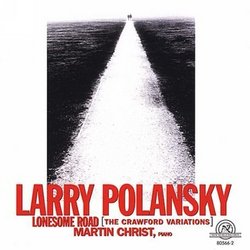Polansky speaks with directedness and conviction
scarecrow | Chicago, Illinois United States | 09/07/2001
(5 out of 5 stars)
"The obvious similar reference to Frederic Rzewski's 36 Variations on Segio Ortega's now international solidarity song, The People United Will Never Be Defeated,is unavoidable. I guess The World Bank and the IMF have things under control now,not to to be threatened by that point of power in Central and South America.
Greatly enough Polansky puts a gulf of meaning,expression,gesture,and content between his fascinating variation edifice here. With Rzewski you always had sensed the Beethoven Diabelli Variations hovering above the proceedings in terms of dramatic unfolding, where variations cumulatively accrete conspire and foment in dramatic force. Rzewski in fact makes a miniature recapitulation at each juncture of the sixth variation,after it.
Here Polansky seems contented with nests,dramatic confluences of piano albums,with simple descriptions and musical forms.We have a 'waltz','dedications' to friends,'Melody',and references to his studies of Indonesian music,although not musical. In terms of large architecture,although there is reference to Three sections here I found it doesn't help the listening experience. You simply have to go it alone, and Polansky admirably rewards your patience. There are quite beautiful moments here as the XX(20) Song, I found evocative.Also much power and fors=ce is here as well, as the Hensley Deviations,after a friend. The First Section has a bunch of 'Chorales',and at first blush I thought that was to function as a structuring device. But I think the work functions much more interestingly enough without such structural templates superimposed on the various unfolding of the variations.And again these variations are beautifully rendered from a miniaturists perspective. I'd almost summon the voice of British tonal miniaturist Howard Skempton as an influence, yet Polansky's music is always much more developed,function bound in a directional way, not contented with itself. And it,the music, must take care of the business of rendering the 'Lonesome Road' Tune.That seems to be the primary intent.I think the vagaries of postmodernity has taught us never to trust whatever the genre is suppose to be,do or say. Polansky is quit honest here,and his music speaks with great conviction and purpose. I would go as far as saying that Polansky resolves the long durational enigma,and paradox,that has leveled many a creative thinkers as Sorabji and the late Morton Feldman. The extended lengths of their music still remain problematical for the listening experience.
Ruth Crawford Seeger had arranged I beleive over 600 American tunes working in the Library of Congress.
Not enough can be said of the playing of Martin Christ who simply brings a refined clarity to the work,mining the gestural problematics of each variation.Great sensitivity, and a beautiful lyrical quality."


 Track Listings (51) - Disc #1
Track Listings (51) - Disc #1